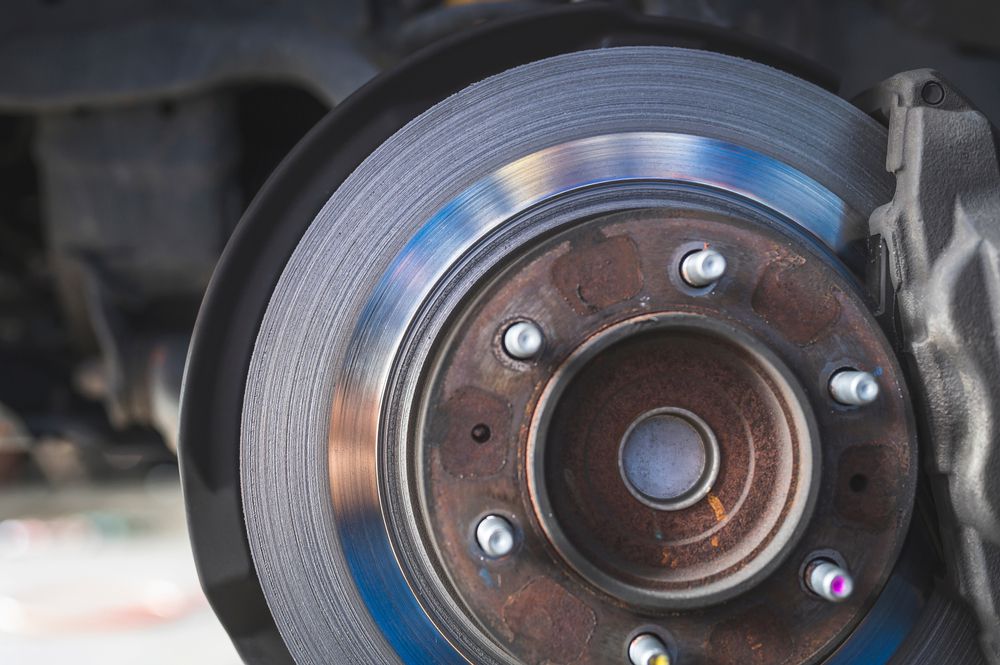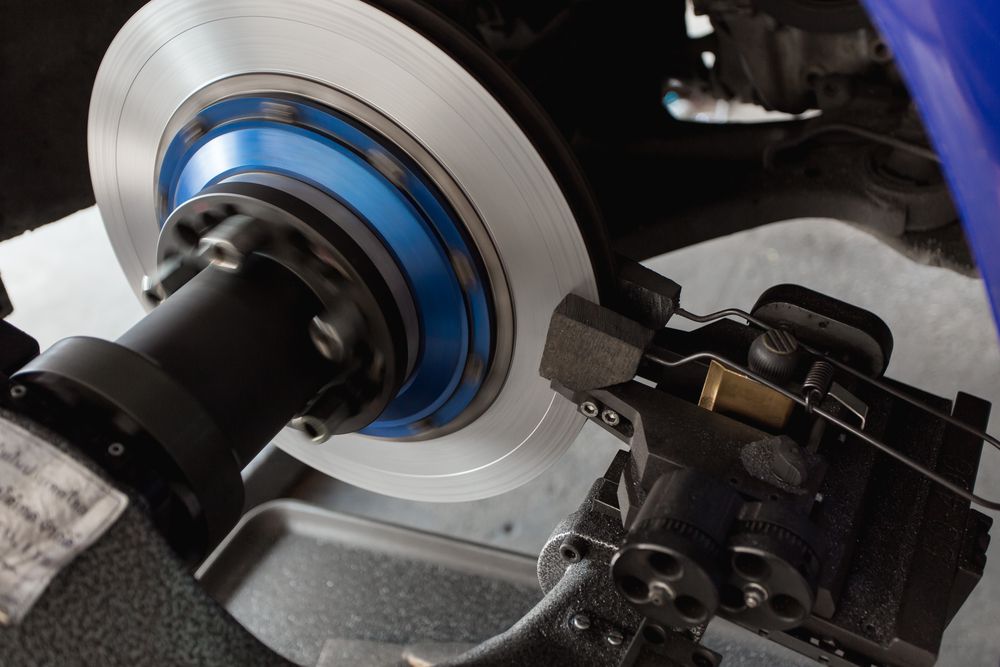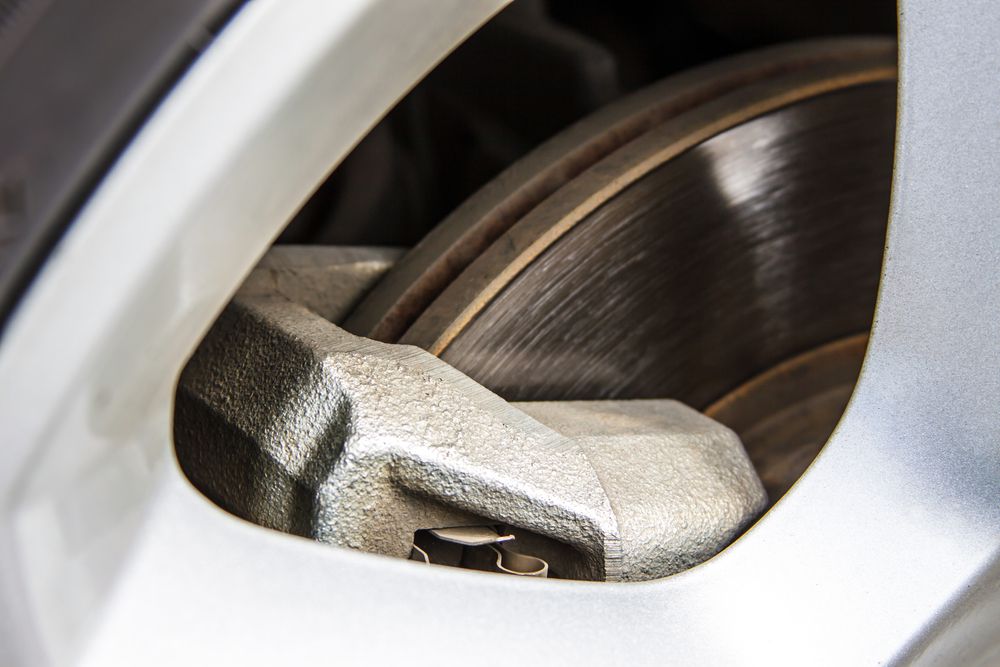
Brake rotors are the metal discs your brake pads are pushed against when
you press your brake pedal. You may notice a few signs that one of your
brake rotors could be going bad.
Your steering wheel may vibrate if your brake rotor is bad. You may
also notice a pulsing feeling from your brake pedal. Grinding or
squealing noises are also a sign of rotor wear. Your rotor may have
visible damage, like grooves or cracks. A failing rotor can also have a
discolored look to it.
If you notice any of these signs, it's time to have your brake rotors
serviced or replaced.
 A mechanic inspecting a worn brake rotor.
A mechanic inspecting a worn brake rotor.
Symptoms Of Bad Brake Rotors
Your brakes are one of the hardest working parts of your vehicle. They are
constantly used to slow down and stop your car, especially in city traffic.
The heat and friction generated by using your brakes will naturally wear
them out over time.
Sometimes this can happen more quickly than normal, so you should be aware
if you notice any of the following symptoms of a bad brake rotor.
1. Vibrating Steering Wheel
If you notice that your steering wheel is vibrating or shaking while
driving, this could be caused by a damaged rotor.
Surface defects or damage to the rotor can cause vibrations when the brakes
are engaged.
Since your braking and steering systems are closely connected, you will
feel any physical movement caused by brake damage in the steering wheel.
2. Brake Pedal Pulsating
A brake rotor should be perfectly straight to work properly. Sometimes, a
rotor can get warped from damage or poor manufacturing quality.
A warp in the rotor will cause the brake pads to jump as they are carried
over the bump created by the warped rotor.
This will cause a pulsating feeling from the brakes up to your pedal.
3. Braking Noises
One of the most obvious signs of a bad rotor is noise from your brakes.
Your brake pads are designed to start making a slight squealing noise when
worn down enough to need replacement. This is a normal sound that's a
reminder of brake maintenance.
However, if your pads wear down to the point of losing the pad material and
making metal contact with the rotor, you will start hearing a loud grinding
noise instead.
This grinding sound is caused by your rotors being damaged. It's also
pretty hard to miss, so paying attention to this sound is important if you
hear it.
4. Grooved Or Scored Rotor
You will sometimes be able to see physical damage on a brake rotor that has
gone bad.
A brake rotor should have a smooth and flat appearance but a slightly rough
texture to provide friction for the brake pads.
If you notice any notches, deep cuts, or grooves in your rotor, it should
be checked by a mechanic as soon as possible to see if it needs to be
replaced.
You can remove some minor surface damage by turning your rotors or
resurfacing with a cutting machine.
However, deep gouges or grooves are not fixable and mean your rotor needs
to be replaced.
Part of your rotor can usually be seen through your rims, so it's a good
idea to inspect them occasionally for any unusual marks.
The best way to check them completely is to remove your tires and inspect
both sides of the rotors.
5. Cracks
A poor-quality rotor, or one that had been badly damaged, can develop
cracks on one or both sides.
It is a serious safety hazard if this happens and can cause complete brake
failure.
Any brake rotor that has visible cracks should be replaced immediately.
6. Discoloration
Occasionally, you may notice that one of your brake rotors has begun to
change color. It may take on a more blue-tinted or copper-reddish-tinted
appearance.
This discoloration is caused by excessive heat that has damaged the metal
of the rotor.
Brake rotors are subject to constant friction during normal use, generating
a lot of heat. Most of the time, this heat can be cooled by the natural
airflow around the tires while driving.
However, sometimes one of the calipers can get stuck while pressing the
brake pads against the rotor. This creates too much friction, which will
overheat the rotor since it doesn't have a chance to cool off.
A discolored and heat-damaged rotor will begin to lose its structural
integrity. This can become dangerous, so you should replace it as soon as
possible.
 Machiining a worn brake rotor.
Machiining a worn brake rotor.
How Long Should Rotors Last?
Under normal driving conditions, brake rotors should last around 50,000 to
70,000 miles without needing to be replaced.
This can vary greatly depending on the weight of your vehicle, your driving
habits, and the type of roads you usually drive on.
Larger and heavier vehicles can expect their rotors to wear out faster than
the average lifespan.
If you do a lot of "hard braking" or quickly slamming on your brakes
instead of gradually stopping, you can also shorten the life of your
rotors.
What Causes Rotors To Go Bad?
Several different things can cause rotors to go bad.
Physical damage caused by impact while driving, such as hitting curbs or
potholes, can be a major cause.
Rotors can also go bad because of issues with the brake system, like
worn-out brake pads grinding against them for too long. Stuck calipers can
also cause rotor failure.
Poor quality manufacturing can also be a cause of rotors wearing out. It
may be tempting to buy a cheap rotor to save money, but it's also risky
since it may be poorly built.
How Long Can You Drive With Bad Rotors?
Ideally, you should only drive for a short time if you know you have a
damaged rotor.
If you have just begun to notice some of the symptoms listed here, then you
should schedule an appointment with a mechanic as soon as possible to check
your brakes.
Some driving may be necessary for emergencies, but you should keep it to a
minimum until your brakes are repaired.
If you have serious physical damage to your rotors, such as cracks or heat
discoloration, you should not drive unless necessary.
 You can inspect a brake rotor throug the wheel on many vehicles.
You can inspect a brake rotor throug the wheel on many vehicles.
How Much Rotor Wear Is Too Much?
Every rotor has a certain minimum thickness that is allowed before it needs
to be replaced.
Once worn enough to reach this level, it will lose its structural integrity
and soon become unsafe to use.
Most rotors have wear indicators stamped on them that show a certain mark
when they have reached this level.
For others, they need to be measured with a special tool to see if they are
at this level.
At What Thickness Should Rotors Be Replaced?
The minimum thickness of a brake rotor will vary from each manufacturer.
Most manufacturers only allow around 2 or 3 millimeters of surface wear
from the original thickness of a new rotor.
A mechanic will have a special tool called a micrometer to measure the
rotor surface's thickness.
This measurement can be checked against a listing in a parts catalog to see
if it is within this limit.
Most rotors also have this wear measurement stamped somewhere on the body,
usually on the top or side away from the braking surface.
How Much Does It Cost To Replace A Rotor?
The cost of a single rotor by itself is usually between $50 and $150. Some
can be cheaper, and some performance models can be significantly more
expensive.
However, there are a few other costs to consider. You should always replace
rotors on the same axle since braking can be affected if you use two rotors
with different thicknesses.
Also, a general rule of thumb is that if your rotors are being replaced,
it's also a good idea to replace the brake pads.
A set of four brake pads will usually cost around $25 to $75 and can be
more expensive for pads made with premium materials that will last longer.
A set of four brake pads and two rotors is enough to complete a brake
replacement for one of the two axles on your vehicle.
If you complete this repair yourself, this is all the cost that will be
involved. However, if you have it done by a mechanic, you can expect to pay
somewhere between $150 and $250 in additional labor costs for each axle.
Conclusion
A car's rotors usually need replacing at least once over the car's
lifetime.
Signs that your car's rotors are wearing out include grinding, a pulsating
brake pedal, and discoloration.